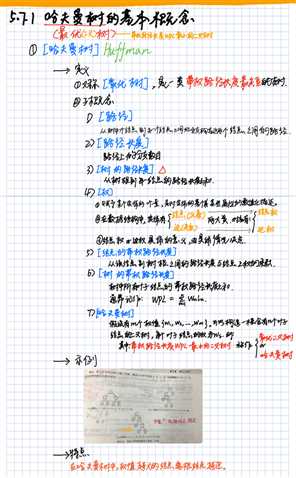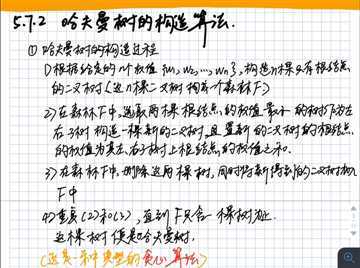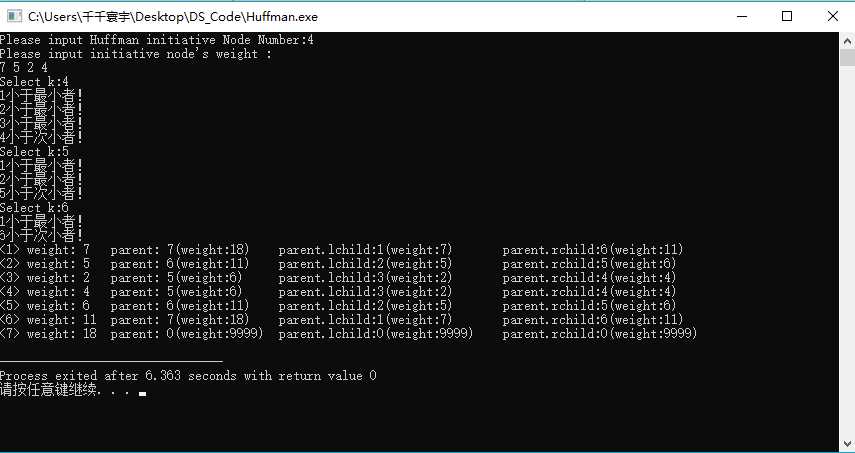标签:过程 fine cout 算法 前缀 alt 单源最短路径 数据结构 归并



# define MAXNEGATIVE -9999 //最大负值
# define MAXPOSITIVE 9999 //最大正值
typedef struct HuffmanNode{ // 加 typedef : 避免发生编译错误 " variable or field 'functionName' declared void "
double weight;
int parent, lchild, rchild; //当前节点的双亲结点、左右孩子结点
}*HuffmanTree;/**
* 选择权值结点最小的两个结点 s1、s2
*/
void Select(HuffmanTree &HT,int k,int *s1,int *s2){
int min[2]={0, 0}; // 升序排名, 保留 HT中 权重值最小的两个结点的下标
cout<<"Select k:"<<k<<endl;
HT[0].weight = MAXPOSITIVE; // 初始化为最大正值,方便被 初始结点比最小而比下去
for(int i=1;i<=k;i++){
// cout<<"i:"<<i<<"\tweight:"<<HT[i].weight<<"\tparent:"<<HT[i].parent<<"\tparent.weight:"<<HT[HT[i].parent].weight<<endl;
if( HT[i].parent==0 && (HT[i].weight<HT[min[1]].weight)){
if(HT[i].weight<HT[min[0]].weight){ // 小于 最小者
min[1] = min[0]; min[0] = i; cout<<i<<"小于最小者!"<<endl;
} else {
min[1] = i;cout<<i<<"小于次小者!"<<endl; //仅小于 次小者
}
}
}
*s1 = min[0]; // 最小者下标
*s2 = min[1]; // 次小者下标
// cout<<"s1:"<<*s1<<"\ts2:"<<*s2<<endl;
}/**
* 创建 Huffman 树
* n : 初试结点(待编码结点)数
*/
void CreateHuffmanTree(HuffmanTree &HT, int n){
int m = 2*n-1;
HT = new HuffmanNode[m+1]; // 0 位空余
cout<<"Please input initiative node's weight : "<<endl; // 输入结点数据
for(int i=1;i<=n;i++){
cin>>HT[i].weight;
}
for(int k=1;k<=m;k++){ // 初始化所有结点
HT[k].lchild = 0;
HT[k].rchild = 0;
HT[k].parent = 0;
}
for(int j=n+1;j<=m;j++){
int s1,s2;
Select(HT, j-1, &s1, &s2); // 选择权值结点最小的两个结点s1、s2
HT[s1].parent = j; // 合并左右结点
HT[s2].parent = j;
HT[j].lchild = s1;
HT[j].rchild = s2;
HT[j].weight = HT[s1].weight + HT[s2].weight;
}
}void OutputHuffmanTree(HuffmanTree &HT, int n){ // 输出 哈夫曼树 中 结点情况
int m = 2*n-1;
for(int i=1;i<=m;i++){
cout<<"<"<<i<<"> weight: "<<HT[i].weight<<"\t"<<"parent: "<<HT[i].parent<<"(weight:"<<HT[HT[i].parent].weight<<")\t";
cout<<"parent.lchild:"<<HT[HT[i].parent].lchild<<"(weight:"<<HT[HT[HT[i].parent].lchild].weight<<")"<<"\t";
cout<<"parent.rchild:"<<HT[HT[i].parent].rchild<<"(weight:"<<HT[HT[HT[i].parent].rchild].weight<<")"<<endl;
}
}int main(){
HuffmanTree HT;
int n;
cout<<"Please input Huffman initiative Node Number:"; // 输入哈夫曼结点初始结点数目 n
int s1, s2;
cin>>n;
CreateHuffmanTree(HT, n);
OutputHuffmanTree(HT, n);
return 0;
}
[C++] 数据结构之哈夫曼树(最优满二叉树) / 哈夫曼编码
标签:过程 fine cout 算法 前缀 alt 单源最短路径 数据结构 归并
原文地址:https://www.cnblogs.com/johnnyzen/p/11589415.html